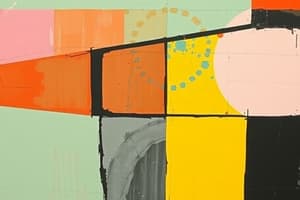Podcast
Questions and Answers
Who was credited with helping develop the stop-motion animation technique in silent cinema?
Who was credited with helping develop the stop-motion animation technique in silent cinema?
- Hal Roach
- Our Gang
- Laurel and Hardy
- Harry Houdini (correct)
Which filmmaker experimented with split-screen, stop-motion, and matte paintings in creating slapstick humor in silent comedy shorts?
Which filmmaker experimented with split-screen, stop-motion, and matte paintings in creating slapstick humor in silent comedy shorts?
- Hal Roach (correct)
- Harry Houdini
- Charlie Chaplin
- Buster Keaton
What was a key aspect of the silent era's special effects that captivated audiences?
What was a key aspect of the silent era's special effects that captivated audiences?
- Traditional theater performances
- Fantasy, magic, and imagination (correct)
- Basic storytelling techniques
- Advanced CGI technology
Which film by Harry Houdini showcased suspenseful scenes created using the stop-motion animation technique?
Which film by Harry Houdini showcased suspenseful scenes created using the stop-motion animation technique?
What does the text suggest about the special effects of the silent era compared to modern cinema?
What does the text suggest about the special effects of the silent era compared to modern cinema?
Which term best describes the silent era's approach to special effects as mentioned in the text?
Which term best describes the silent era's approach to special effects as mentioned in the text?
How did the Lumière Brothers create the illusion of objects coming to life in their 1896 short film 'Le voyage dans la lune'?
How did the Lumière Brothers create the illusion of objects coming to life in their 1896 short film 'Le voyage dans la lune'?
What technique did Georges Méliès master that allowed him to create dazzling illusions in his films?
What technique did Georges Méliès master that allowed him to create dazzling illusions in his films?
Which filmmaker is known as 'The Father of Fantasy Film' due to his enchanting special effects in silent cinema?
Which filmmaker is known as 'The Father of Fantasy Film' due to his enchanting special effects in silent cinema?
In silent cinema, what method did creators like the Lumière Brothers and Georges Méliès use to engage and surprise audiences?
In silent cinema, what method did creators like the Lumière Brothers and Georges Méliès use to engage and surprise audiences?
What was one of Georges Méliès' notable achievements in special effects in silent cinema?
What was one of Georges Méliès' notable achievements in special effects in silent cinema?
Which innovative technique did the Lumière Brothers pioneer in early cinema that involved photographing the same scene multiple times?
Which innovative technique did the Lumière Brothers pioneer in early cinema that involved photographing the same scene multiple times?
Flashcards are hidden until you start studying
Study Notes
Unraveling the Enchantment of Silent Cinema: Special Effects and Innovation
Silent cinema, a captivating era that spanned between the late 19th and mid-20th centuries, witnessed the birth of cinematic storytelling without the aid of synchronized dialogue or sound. With creators striving to engage and surprise audiences, the use of special effects became an integral part of silent filmmaking. As we delve into the history of this era, we'll explore the unique strategies employed to create stunning visuals and evoke awe, without the crutch of audio.
The Art of Lumière Brothers' Trickery
In the early days of cinema, Louis and Auguste Lumière pioneered several innovative techniques. One such method, the use of multiple exposures, was an early form of special effect. By photographing the same scene multiple times and then superimposing these images, they created the illusion of objects coming to life, such as a tree sprouting branches or a house vanishing, as seen in their 1896 short "Le voyage dans la lune" (A Trip to the Moon).
Georges Méliès: The Father of Fantasy Film
Georges Méliès, a French stage magician, brought a unique flair to silent cinema with his enchanting special effects. Méliès mastered the hand-painted matte shot, allowing him to create dazzling illusions such as the appearance of ghosts or the transformation of ordinary objects. His 1902 short film, "Le voyage dans la lune," is one of the most recognized examples of Méliès' ingenious effects.
The Grand Illusionist: Harry Houdini
Harry Houdini, a world-renowned magician and escape artist, also dipped his toes into the waters of silent cinema. Houdini, who was no stranger to the art of illusion, helped develop the stop-motion animation technique, which allowed objects to appear and disappear on screen. In his 1919 film "The Grim Game," Houdini utilized this technique to create suspenseful scenes.
Hal Roach Studios: The Comedy of Attraction
Hal Roach, a pioneering filmmaker based in California, produced groundbreaking silent comedy shorts featuring characters like "Our Gang" (also known as "The Little Rascals") and "Laurel and Hardy." To create the slapstick humor central to these films, Roach experimented with a multitude of special effects, including split-screen, stop-motion, and matte paintings.
The Silent Era's Legacy
The silent era laid the foundation for many of the techniques and styles that are still used in filmmaking today. Although many of these effects seem primitive in comparison to the cutting-edge CGI of modern cinema, they demonstrate the ingenuity and creativity of early filmmakers. The silent era's unique approach to special effects blended fantasy, magic, and imagination, producing captivating films that continue to captivate audiences today.
Silent cinema was a grand experiment in the art of storytelling, and its unique special effects played a significant role in captivating audiences. These early filmmakers mastered techniques that have since evolved and grown into the world of modern cinema. As we continue to explore the enchanting world of narrative film, we must remember the innovative filmmakers who defined the silent era and paved the way for the cinema we know today.
Studying That Suits You
Use AI to generate personalized quizzes and flashcards to suit your learning preferences.




